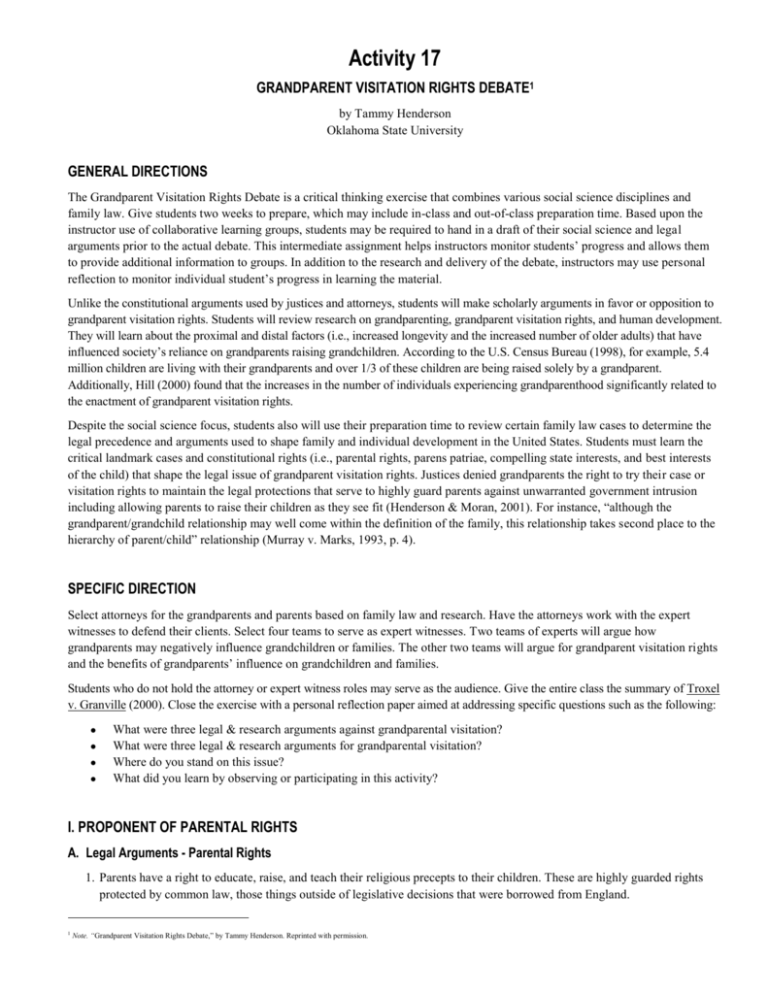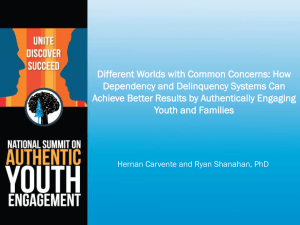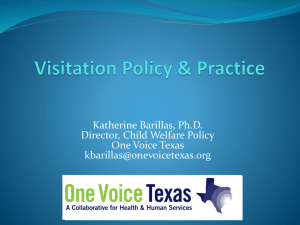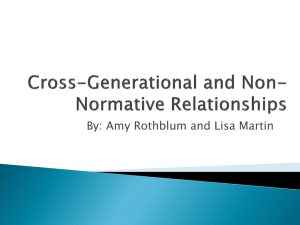Grandparent Visitation Rights Debate
advertisement

Activity 17 GRANDPARENT VISITATION RIGHTS DEBATE1 by Tammy Henderson Oklahoma State University GENERAL DIRECTIONS The Grandparent Visitation Rights Debate is a critical thinking exercise that combines various social science disciplines and family law. Give students two weeks to prepare, which may include in-class and out-of-class preparation time. Based upon the instructor use of collaborative learning groups, students may be required to hand in a draft of their social science and legal arguments prior to the actual debate. This intermediate assignment helps instructors monitor students’ progress and allows them to provide additional information to groups. In addition to the research and delivery of the debate, instructors may use personal reflection to monitor individual student’s progress in learning the material. Unlike the constitutional arguments used by justices and attorneys, students will make scholarly arguments in favor or opposition to grandparent visitation rights. Students will review research on grandparenting, grandparent visitation rights, and human development. They will learn about the proximal and distal factors (i.e., increased longevity and the increased number of older adults) that have influenced society’s reliance on grandparents raising grandchildren. According to the U.S. Census Bureau (1998), for example, 5.4 million children are living with their grandparents and over 1/3 of these children are being raised solely by a grandparent. Additionally, Hill (2000) found that the increases in the number of individuals experiencing grandparenthood significantly related to the enactment of grandparent visitation rights. Despite the social science focus, students also will use their preparation time to review certain family law cases to determine the legal precedence and arguments used to shape family and individual development in the United States. Students must learn the critical landmark cases and constitutional rights (i.e., parental rights, parens patriae, compelling state interests, and best interests of the child) that shape the legal issue of grandparent visitation rights. Justices denied grandparents the right to try their case or visitation rights to maintain the legal protections that serve to highly guard parents against unwarranted government intrusion including allowing parents to raise their children as they see fit (Henderson & Moran, 2001). For instance, “although the grandparent/grandchild relationship may well come within the definition of the family, this relationship takes second place to the hierarchy of parent/child” relationship (Murray v. Marks, 1993, p. 4). SPECIFIC DIRECTION Select attorneys for the grandparents and parents based on family law and research. Have the attorneys work with the expert witnesses to defend their clients. Select four teams to serve as expert witnesses. Two teams of experts will argue how grandparents may negatively influence grandchildren or families. The other two teams will argue for grandparent visitation rights and the benefits of grandparents’ influence on grandchildren and families. Students who do not hold the attorney or expert witness roles may serve as the audience. Give the entire class the summary of Troxel v. Granville (2000). Close the exercise with a personal reflection paper aimed at addressing specific questions such as the following: What were three legal & research arguments against grandparental visitation? What were three legal & research arguments for grandparental visitation? Where do you stand on this issue? What did you learn by observing or participating in this activity? I. PROPONENT OF PARENTAL RIGHTS A. Legal Arguments - Parental Rights 1. Parents have a right to educate, raise, and teach their religious precepts to their children. These are highly guarded rights protected by common law, those things outside of legislative decisions that were borrowed from England. 1 Note. “Grandparent Visitation Rights Debate,” by Tammy Henderson. Reprinted with permission. 2. In common law, grandparental visitation is a moral obligation, not a legal one. 3. Because parental rights are so highly guarded, the government must have a compelling reason to intervene with parental and family autonomy. This is a long tradition in our country. 4. Review of landmark U. S. Supreme Court Cases a. Meyer v. Nebraska (1923) Parental rights are also protected by landmark U. S. Supreme Court decisions that protect parents’ right to raise their children as they see fit. In Meyer v. Nebraska (1923), a Nebraska statute required that only English be taught in schools. The government had an interest in educating its citizens so that they may become productive members of society. Parents of a minor child hired an instructor to teach German who was later arrested and convicted of violating this Nebraska statute. The Supreme Court acknowledged that, although the statute had good intentions, it overextended its powers and violated the parent’s liberty interests in teaching their children another language. Furthermore, learning another language did not cause harm to the health, morals, or development of the child. b. Wisconsin v. Yoder (1972) The religious practices of Amish parents were protected against a government’s compulsory education statute in Wisconsin v. Yoder (1972). The government interest in having compulsory education served to educate children, to reduce the incidence of child labor that might displace adult workers, and to reduce the chance of idleness. Despite these government interests, Amish children in Wisconsin v. Yoder (1972) received an eighth grade education, which was sufficient to meet their basic needs. Amish children were trained to use farm equipment, thereby removing the compelling government interest of threat of harm or danger to a child. They were not displacing workers in the nearby community with child labor, but maintaining the farming tradition of the Amish. Based largely on these facts, the U. S. Supreme Court held that the compulsory education statute violated Amish parents’ rights to determine the religious upbringing of their children. c. Pierce v. Society of Sisters (1925) Parents’ right to raise and educate sometimes conflict with the government’s interest in having a literate citizenry [Pierce v. Society of Sisters (1925)]. For example, Oregon’s Compulsory Education Act required all children between the ages of 8 and 16 to attend public schools allowing exceptions for children with special needs or who have already completed eight years of schooling. Justices held that this act “unreasonably interferes with the liberty of parents and guardians to direct the upbringing and education of children under their control” (Pierce v. Society of Sisters, 1925, p. 6). B. Best Interests of the Child The best interest of the child is served when parental rights are protected. Others argued that parental unfitness or child endangerment, including child maltreatment, are the only circumstances that justify government intrusion on parental rights. Protecting a child in these two circumstances promotes the child’s best interest (Bohl, 1996). C. Adoptive Parents Adoptive parents hold the same highly guarded rights as parents. D. Sample of Arguments Based on Research - Expert Testimony 1. Family research indicates that grandparent-grandchild relationships may sometimes have adverse influences on a child by undermining parental authority and religious precepts (Thompson, Tinsley, Scalora, & Parke, 1989). 2. Children may also experience psychological stress due to split loyalties between parents and grandparents. 3. Others are concerned that children will be placed at the center of conflicts between parents and a grandparent, resulting in additional psychological stress that undermines the child’s best interest (Bostock, 1994; Jackson, 1994; Purnell & Bagby, 1993; Thompson, Tinsley, Scalora, & Parke, 1989). 4. For instance, Thompson and his colleagues (1994) argued that justices tend to grant visitation rights to grandparents under exceptional circumstances of family disruption. NOTE: Have the students review other literature to find at least three arguments to support parental rights. II. PROPONENTS OF GRANDPARENT VISITATION RIGHTS A. Government Interests In a time when families are experiencing high levels of divorce, single parent families, parental incarceration and substance abuse, along with parental abuse and neglect of children, the government has an interest in maintaining intergenerational ties. B. Best Interests of the Child 1. The best interest of the child is served when parental rights are protected. Others argued that parental unfitness or child endangerment, including child maltreatment, are the only circumstances that justify government intrusion on parental rights. 2. The grandparent may provide the child with some continuity after experiencing such a loss. 3. The best interests of the child was interpreted to mean grandparents’ deep concern for or significant relationship with the grandchild (King v. King, 1992) and grandparents’ economic support of their grandchild (Bostock, 1994; Burns, 1991; Estate of Topel, 1966; In re Emanuel S v. Joseph E, 1991; In the Matter of the Grandparental Visitation of C. G. F., 1992). 4. Review pertinent cases. C. Derivative of Rights Some states, including Washington, have derivative of rights statutes. These statutes allow grandparents to have access to their grandchildren when their own child does not have access due to death, incompetence, unfitness, or incarceration. 1. If the parent of the child loses their parental rights as a result of divorce or some other form of termination, then the grandparent loses all legal ties to their grandchild. 2. According to Balzer (1994), if a parent died, the related grandparent could petition for visitation with his or her grandchild. 3. Sample Cases a. King v. King (1992) According to King v. King (1992), the Supreme Court of Kentucky held that grandparent visitation was in the child’s best interest. These were the facts: Stewart and Ann King lived on a farm owned by Stewart’s father. Before a family dispute, the grandfather enjoyed daily contact with his grandchild. After they moved, Stewart and Ann discontinued the visits between the grandfather and grandchild; the grandfather petitioned for visitation. The parents argued that grandparent visitation under the Kentucky statute violated their parental rights. The Supreme Court of Kentucky heard this case in order to decide whether the trial court’s decision, which granted grandparent visitation to serve the child’s best interest, violated the parents’ constitutional rights. This court reasoned that disputes among adults should not disrupt the grandparentgrandchild relationship. The court also believed that the continuation of a loving relationship was in the child’s best interest. Furthermore, the justices believed that the grandparent-grandchild relationship benefited both parties. For instance, grandchildren are exposed to the insights of grandparents and grandparents are spared loneliness and isolation. The statute also served to protect the child’s rights by using the best interest of the child standard to maintain a substantial intergenerational tie. The father, Stewart King, admitted that his father loved, nurtured, and provided a safe place for the child. Both the grandfather and the son agreed that a substantial relationship existed between the grandchild and grandfather. This decision also focused on the substantial relationship and the best interest of the child. b. In re the Matter of Grandparental Visitation of C. G. F. (1992). For example, in one case, after the death of the biological father, the grandchild remained in the custody of the mother who allowed visitation by the paternal grandparents (In re the Matter of Grandparental Visitation of C. G. F., 1992). These visitations gradually decreased until the mother remarried and finally refused to allow any visitation. Not long after the marriage, the stepfather began adoption proceedings. The grandparents petitioned for visitation. The trial court held that visitation was in the child’s best interest, but the grandparent right to visit would terminate upon an adoption. After the adoption, the grandparents filed a petition opposing the condition set by the trial court. The Court of Appeals, relying heavily on another case, affirmed the trial court’s decision to terminate visitation rights upon the adoption. The Wisconsin Supreme Court reversed the Court of Appeals decision and concluded that the paternal grandparents had a lawful right to visitation. In short, the father in C. G. F. (1992) continued to hold his parental rights, even in death. Because the father continued to hold his parental rights, the grandparents’ right to visitation via their own child also continued. Justices acted to promote the best interest of the grandchild by allowing a continued relationship with the grandparents (Michaels, 1993). D. Sample of Arguments Based on Research 1. In the mid-1990s, 94% of older adults are grandparents (Hooyman & Kiyak, 1996). 2. Accordingly, 5.4 million children live with their grandparents. One-third of these children living with grandparents are being raised by their grandparents or a family member other than the child’s parent (U. S. Bureau of the Census, 1998). 3. Grandparents are raising grandchildren to contribute to their grandchildren’s lives, to intervene when a parent dies or is incarcerated, or to smooth out the negative influences of divorce (Jendrek, 1994; Minkler & Roe, 1996; Weibel-Orlando, 1997). 4. On the other hand, some grandparents simply want to participant in their grandchild’s life which has led to the enactment and court petitions for grandparental visitation rights (McCrimmon & Howell, 1989; Walther, 1997). NOTE: Have students review other literature to find at least three other points to argue for grandparental rights. III. PERSONAL REFLECTION A. Government Interests 1. What were three legal and research arguments against grandparental visitation? 2. What were three legal and research arguments for grandparental visitation? 3. Where do you stand on this issue? 4. What did you learn by observing or participating in this activity? A LESSON FROM THE U.S. SUPREME COURT The Story Brad Troxel and Tommie Granville Wynn, the parents of two girls, never married. When they ended their relationship, the father moved back in with his parents. The children visited the father in his parents’ home for around two years. Consequently, the grandparents saw the girls weekly. The grandparents attended the girls’ sport functions and actively followed their school progress. The father committed suicide. Wynn at first allowed the children to visit their paternal grandparents only once a month. Shortly following the tragedy, the mother discontinued visits between the paternal grandparents and the two girls altogether because the paternal grandparents did not want to adhere to monthly visits. The grandparents filed for court-ordered visitation. Sometime between the lower and appellant court decisions, the mother remarried and the stepfather adopted the child. Adoptive parents, such as the stepfather in this case, have the same rights as biological parents. Consequently, the parents argued that the adoption severed all legal ties with the paternal grandparents. Through the course of legal events, the dispute centered around the paternal grandparents’ desire for two visits per month and two full weeks in the summer and the parents’ agreeing to one visit per month and special holidays. Court Outcomes The first court granted the grandparents visitation expanding the visitation to one weekend per month, one week during the summer, and four hours on each of the paternal grandparents’ birthdays. The Washington Court of Appeal ruled in favor of the parents by dismissing the visitation petition and terminating the expanded visitation order. The Washington State Supreme Court also held in favor of the mother and adoptive father, denying the visitation petition because there was no custody suit pending and the Washington’s visitation statute unfairly interfered with the rights of the parents. The U. S. Supreme Court heard the case and rendered the decision on June 5, 2000. The U. S. Supreme Court reasoned that giving third parties, anyone but parents, visitation rights because it served the best interests of the child made Washington’s statute too broad. The U. S. Supreme Court, without explicitly citing the legal standard of review, concluded that the government could not interfere in the rights of parents without a compelling reason such as threat of harm to the child or unfit parents. Due to the lack of these two conditions, the state of Washington had no compelling reason to grant grandparental visitation and to interfere with the primacy of the parent-child relationship. The Court acknowledged that the Washington State Supreme Court accurately applied the legal presumption that fit parents act in the best of interests of children. Yet, the U. S. Supreme Court failed to render a decision about the constitutionality of Washington’s or the other 49 state statutes. Justice Stevens disagreed with the broadness ruling made by the majority suggesting that Washington’s adoption, child custody, and guardianship statutes provided a definitive criterion for establishing the best interests of the child standard. Interpretation Based on the U. S. Supreme Court decision, parental rights prevailed over that of grandparents, but the lack of explicit direction on the legal review to be used in deciding these cases gives justices and states considerable flexibility (Troxel v. Granville, 2000). Grandparent visitation rights remain under the discretion of state justices of all court levels. REFERENCES Balzer, C. L. (1994). Grandparent visitation rights - constitutional considerations and the need to define the “best interests of the child standard.” Land and Water Law Review, 29: 593-613. Black’s Law Dictionary. Sixth Edition. s.v. “parens patriae.” Becker v. Becker, 262 N.J. Super. 311; 620 A.2d 1092; 1992 N.J. Super. LEXIS 479. Available from: http://web.lexis-nexis.com.; INTERNET. Bohl, J. C. (1996). The Unprecedented Intrusion: A Survey and Analysis of Selected Grandparent Visitation Cases. Oklahoma Law Review, 33: Available from: http://web.lexis-nexis.com. INTERNET. Bostock, C. (1994). Does the Expansion of Grandparent Rights Promote the Best Interests of the Child?: A Survey of Grandparent Visitation Laws in the Fifty States. Columbia Journal of Law and Social Problems, 27: 319-373. Brooks et al. v. Parkerson, 265 Ga. 189; 454 S.E.2d 769; 1995 Ga. LEXIS 157; 95 Fulton County DR P1103. Available from: http://web.lexis-nexis.com. INTERNET. Burns, E. M. (1991). Grandparent Visitation Rights: Is it Time for the Pendulum to Fall? Family Law Quarterly, 25: 59-81. Cox, C. B. (2000). Why Grandchildren Are Going to and Staying at Grandmother’s House and What Happens When They Get There. In To Grandmother’s House We Go and Stay, edited Carole B. Cox. New York: Springer Publishing Company. Foster, H. H., & Freed, D. J. (1984). The Child’s Right to Visit Grandparents: An Emerging Question of Visitation Rights. Trial, 18: 38-45. Hartfield, B. W. (1996). Legal Recognition of the Value of Intergenerational Nurturance: Grandparent Visitation Statutes in the Nineties. Generations, 20: Available: http:// web2.searchbank.com/infortrac. Harvard Law Review. (1980). Developments in the Law: The Constitution and the Family. Boston, MA: author. Henderson, T. L., & Moran, P. B. (2001). Grandparent Visitation Rights: Testing the Parameters of Parental Rights. Journal of Family Issues. Hicks v. Enlow, Ky., 764 S.W.2d 68 (1989). Hill, T. J. (2000). Legally Extending the Family: An Event History Analysis of Grandparent Visitation Rights Law. Journal of Family Issues, 21, 246-261. In the Matter of the Grandparental Visitation of C. G. F., H. F., T. F. v. T. F. & D. L., 168 Wis. 2d 62; 483 N.W.2d 803; 1992 Wisc. LEXIS 199. Available: http://web.lexis-nexis.com. King v. King, 929 S. W. 2d 630 (KY, 1992). McMain v. Iowa District Court for Polk County, 559 N.W.2d 12; 1997 Iowa Sup. LEXIS 60. Available from: http://web.lexis-nexis.com.; INTERNET. Meyer v. Nebraska, 262 U.S. 390 (1923). Mnookin, R. H., & Weisburg, D. K. (1993). Child, Family, and State: Problems and Materials on Children and Law (2nd ed.). Boston, MA: Little, Brown and Company. Moore v. the City of East Cleveland, 431 U.S. 494; 97 S. Ct. 1932; 1977 U.S. LEXIS 17; 52 L. Ed. 2d 531. Murray v. Marks, 1993 Del. Fam. Ct. LEXIS 86: http://web.lexis-nexis.com. (23 February 1999). Pierce v. the Society of Sisters, 268 U S. 510; 45 S. Ct. 571; 1925 U.S. LEXIS 589; 69 L. Ed. 1070; 39 A.L.R. 468. Prince v. Massachusetts, 321 U.S. 158 (1944). Segal, E. C., & Karp, N. (1989). Grandparent visitation disputes: A legal resource manual. Washington D. C.: American Bar Association, Commission on Legal Problems of the Elderly. Stanley v. Illinois, 405 U.S. 645; 92 S. Ct. 1208; 1972 U.S. LEXIS 70; 31 L. Ed. 2d 551. Steward v. Steward, 111 Nev. 259; 890 P.2d 777; 1995 Nev. LEXIS 17. Available from: http://web.lexis-nexis.com. INTERNET. Troxel v. Granville, 120 S. Ct. 2054 U. S. LEXIS 3767; 147 L. Ed. 2d 49; 68 U. S. L. W. 4458; 2000 Cal. Daily Op. Service 4345; 2000 Daily Journal DAR 5831; 12 Fla. W. Fed. S. 365. Available from: http://web.lexis-nexis.com. INTERNET. U.S. Bureau of the Census. (1998). Co-Resident Grandparents and Grandchildren (P23-198). http://www.census.gov/population/www/socdemo/grandparents.html (1 Oct 1999). Walther, D. L. (1997). Survey of Grandparents Visitation Rights. American Journal of Family Law, 11: 95-107. Ward v. Ward, Del. Fam. Ct., 537 A.2d 1063 (1987). Wisconsin v. Yoder, 406 U.S. 205 (1972).








